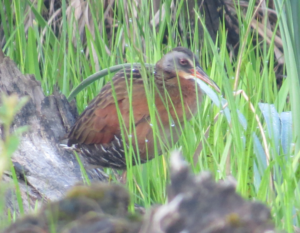(Story and photos by Pam Hunt)
Wetland birds, especially those that prefer dense and/or inaccessible cattail marshes, are among the most poorly known members of New Hampshire’s avifauna. Perhaps the most common of these is the Virginia Rail (Rallus limicola), and although widely distributed across the state this secretive bird is still rarely seen. In addition to cattail marshes, this species will use salt marsh and freshwater wetlands with a mix of shrubs and grasses. Key habitat elements include areas of mud or shallow water that are used for foraging. Virginia Rails tend to prefer larger marshes, but regularly shows up in some as small as an acre, and during migration may show up in places as incongruous as wet roadside ditches with tall grass.

The phrase “thin as a rail” refers to these species’ laterally-compressed bodies, which presumably make it easier for them to move through dense marsh vegetation. Even their head feathers are modified to reduce the wear induced by constantly pushing their way through the tough leaves and stems of cattails and similar plants. In these dense wetlands a pair of rails will build their simple nest of loosely woven grass just above the water level and lay 8-10 eggs. After 20 days these hatch into fluffy black chicks which leave the nest by the time they are four days old and are foraging on their own after a week. Seeing these black puffballs with their oversized feet is a rare joy of marsh watching in the New England summer.
Rails, instead, are heard more often than seen and possess an impressive repertoire. The most common call is a harsh series of grunting noises that descends in pitch. After one bird in a marsh makes this vocalization, others may follow in short order. Males and females also have what are called songs, both being sharper than the grunts. The male’s song is often rendered as “ka-dik ka-dik ka-dik,” while the female’s is a rapid “ki-ki-ki-ki-ki-ki-kedew” that descends at the end. Virginia Rails also make a number of shorter grunting and squeaking noises that can indicate their presence in a given marsh.
Audio Player
Because rails are so secretive, this is the first species featured for “Bird of the Month” without a trend graph. The occasional Virginia Rail is detected on the Breeding Bird Survey, but there are not enough data to determine whether populations are increasing or decreasing. Available data on other marsh birds such as American Bittern and Pied-billed Grebe suggest decreases in New Hampshire, and since rails use the same habitats they might be suffering the same fate. Elsewhere in North America the data aren’t any better and show a mix of local increases and decreases where marshes have been studied in detail for longer periods of time. Given the lack of data, a key need for rails and other marshbirds in New Hampshire is better information on their distributions. You can help by visiting local marshes between mid-April and late June, listening for these species’ calls, and reporting your observations to eBird. The grunting of a Virginia Rail from the cattails in late April may be less appealing than the song of a Hermit Thrush, but it’s still a welcome sign that spring has returned to New Hampshire’s wetlands!
State of the Birds at a Glance:
- Habitat: Marsh and shrub wetlands, saltmarsh
- Migration: Short-distance
- Population trend: Unknown but possibly declining
- Threats: Invasive species, altered wetland hydrology
- Conservation actions: Protect wetlands
